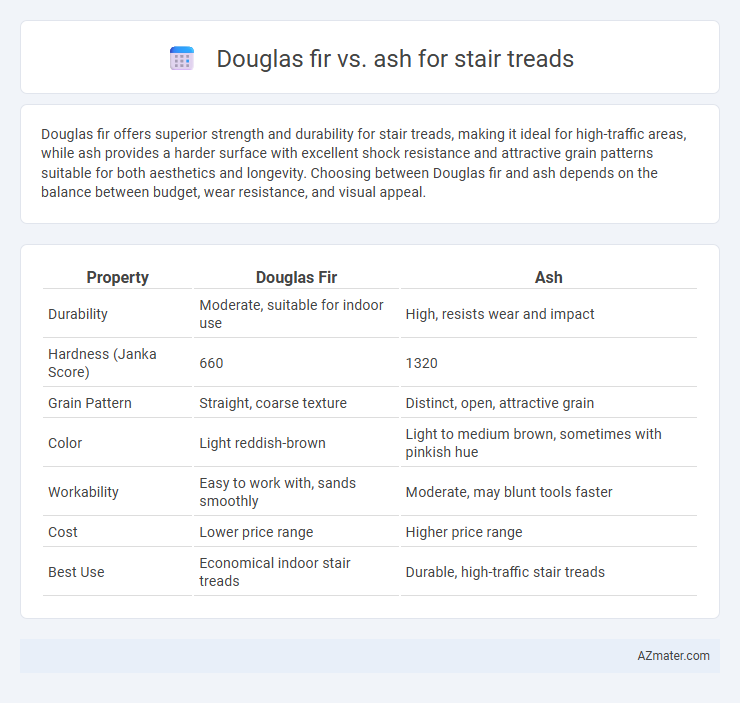Douglas fir offers superior strength and durability for stair treads, making it ideal for high-traffic areas, while ash provides a harder surface with excellent shock resistance and attractive grain patterns suitable for both aesthetics and longevity. Choosing between Douglas fir and ash depends on the balance between budget, wear resistance, and visual appeal.
Table of Comparison
| Property | Douglas Fir | Ash |
|---|---|---|
| Durability | Moderate, suitable for indoor use | High, resists wear and impact |
| Hardness (Janka Score) | 660 | 1320 |
| Grain Pattern | Straight, coarse texture | Distinct, open, attractive grain |
| Color | Light reddish-brown | Light to medium brown, sometimes with pinkish hue |
| Workability | Easy to work with, sands smoothly | Moderate, may blunt tools faster |
| Cost | Lower price range | Higher price range |
| Best Use | Economical indoor stair treads | Durable, high-traffic stair treads |
Introduction: Douglas Fir vs Ash for Stair Treads
Douglas fir and ash are popular choices for stair treads, each offering unique durability and aesthetic qualities. Douglas fir is known for its strength-to-weight ratio and warm, reddish-brown tones, making it suitable for high-traffic areas. Ash delivers a harder surface with distinctive grain patterns and light color, providing both resilience and a modern look for stair applications.
Visual Appearance and Grain Patterns
Douglas fir stair treads showcase a warm, reddish-brown hue with straight, pronounced grain patterns that create a rustic, natural aesthetic. Ash offers a lighter, creamy tone with a more uniform and distinct grain, characterized by bold, cathedral-like patterns that add visual interest. Both woods provide durability, but Douglas fir's rich coloration contrasts with ash's brighter appearance, influencing the overall ambiance of stair design.
Durability and Hardness Comparison
Douglas fir offers moderate durability with a Janka hardness rating of approximately 660, making it softer and more prone to dents and wear compared to ash. Ash, with a higher Janka hardness around 1320, provides superior hardness and resistance to impact, making it more suitable for high-traffic stair treads. The greater density and durability of ash ensure longer-lasting stair surfaces that maintain their appearance under heavy use.
Cost Differences and Budget Considerations
Douglas fir stair treads typically cost less than ash, making them a budget-friendly option for staircase projects. Ash, known for its durability and attractive grain, commands a higher price due to its hardwood classification and aesthetic appeal. When considering cost differences, Douglas fir is ideal for cost-conscious renovations, while ash fits better in budgets prioritizing long-term wear and premium finishes.
Workability and Installation Ease
Douglas fir offers superior workability for stair treads due to its moderate hardness and straight grain, allowing for easier cutting, sanding, and shaping compared to harder woods. Ash, while known for its strength and durability, presents slightly more challenges during installation owing to its higher density and interlocked grain, which can dull tools faster. Both woods require proper pre-drilling for fasteners, but Douglas fir's forgiving nature makes installation generally quicker and less labor-intensive.
Maintenance and Longevity Factors
Douglas fir stair treads offer moderate maintenance needs with a natural resistance to decay but require periodic sealing to prevent wear and moisture damage. Ash provides superior hardness and durability, making it more resistant to dents and scratches, thereby reducing the frequency of refinishing and repairs. Both woods benefit from regular cleaning, but ash's longevity typically surpasses Douglas fir, especially in high-traffic areas.
Environmental Impact and Sustainability
Douglas fir offers a sustainable choice for stair treads as it grows relatively quickly and is widely available from responsibly managed forests certified by the Forest Stewardship Council (FSC). Ash, while durable and visually appealing, has a slower growth rate and faces pressure from overharvesting and threats like the emerald ash borer, impacting its long-term availability. Choosing Douglas fir from certified sources reduces environmental impact through faster renewal rates and lower habitat disruption compared to ash.
Slip Resistance and Safety
Douglas fir offers moderate slip resistance due to its fine grain texture, making it a popular choice for stair treads in residential settings. Ash wood provides superior slip resistance with its open grain structure, enhancing grip and overall safety on stair surfaces. When prioritizing safety, ash's higher hardness and traction properties reduce the risk of slips and falls compared to Douglas fir.
Best Use Cases for Douglas Fir Stair Treads
Douglas fir stair treads excel in high-traffic residential and commercial areas due to their durability and resistance to wear, making them ideal for staircases that require long-lasting performance. Their natural strength and tight grain structure provide excellent impact resistance, suitable for both traditional and modern stair designs. Douglas fir's warm amber tones and stability under varying humidity conditions enhance aesthetic appeal and structural integrity in environments prone to moisture fluctuations.
Best Use Cases for Ash Stair Treads
Ash stair treads are ideal for high-traffic areas due to their exceptional hardness and durability, making them resistant to dents and wear over time. The wood's natural light color and straight grain provide a modern aesthetic that complements contemporary interior designs, while its good shock resistance ensures long-lasting performance on staircases. Compared to Douglas fir, ash offers superior strength and stability, making it the preferred choice for residential and commercial stair treads where safety and longevity are priorities.

Infographic: Douglas fir vs Ash for Stair Tread
 azmater.com
azmater.com